Information
Discovery of the lime kiln of the Tang Dynasty at Gongyi Kiln, Henan
Summary: The Gongyi Kiln site, located in the northeast of the Gongyi City, Henan Province, was famous for the manufactory of white porcelain and tri-color glazed pottery of Tang dynasty (Tang Sancai) during the Sui and Tang Dynasties.
The Gongyi Kiln site, located in the northeast of the Gongyi City, Henan Province, was famous for the manufactory of white porcelain and tri-color glazed pottery of Tang dynasty (Tang Sancai) during the Sui and Tang Dynasties. From 2015 October to 2016 June, salvage excavation was conducted by the Henan Provincial Institute of Archaeology and Cultural Relics. The excavation covers an area of 5010 square meters, where several different type kilns, filter pools, cave dwelling and pottery kitchen range were recovered along with many ceramic remains.
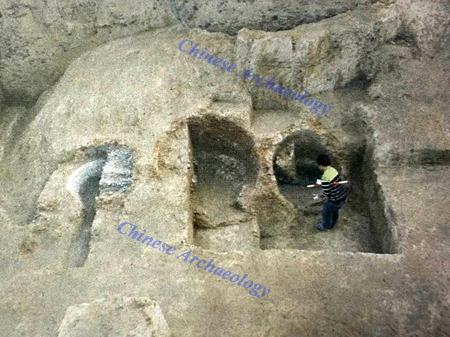
Three Kilns numbered Y2, Y7 and Y8 , dating back to the early Tang Dynasty
Features
8 kilns have been discovered in total. In addition, there were 16 ash pits, 6 tombs, 2 footpaths, 3 ash ditches, 15 house-remains, 34 pottery kitchen ranges, 7 pools and 2 water wells found in the site.
The 8 kilns varied in shape. Kiln Y2, Y7 and Y8 were spoon-shaped, probably dating to the early Tang Dynasty. As white ashes and stones were filled inside, those kilns might have been used to produce limes. Kiln Y6 was oval-spoon shaped. The firebox was located in the west part, forming a wedge-like shape. This kiln, resembling kilns Y2, Y7 and Y8, was also dated to the early Tang Dynasty. Very likely, it was used for firing pottery ware.
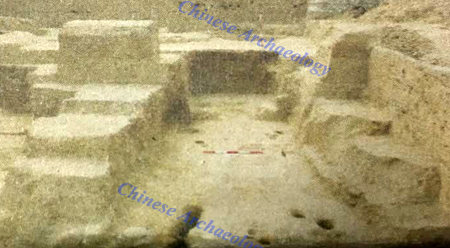
House foundation F5
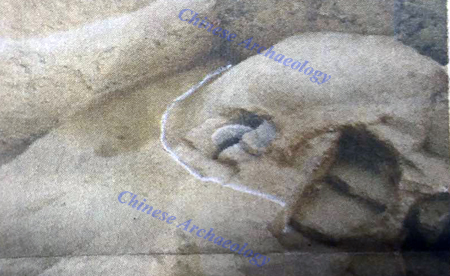
Footpath dating back to the early Tang Dynasty found in T0131,which is overlying on the lime kiln
Totally 16 ash pits were discovered. In kiln H1, H2, H5, H7, H12, H17 and H18, tri-color glazed pottery Sancai fragments were collected together with kiln furniture, pottery mould and ovens. Chronologically, they might have been used during the Tang Dynasty. Pit H8, where figure mould, tri-color porcelain, and Jun porcelain plates were deposited, probably was dated to the Song Dynasty. Pit H10 was oval shaped, of which the wall was irregularly constructed. Within the pit, porcelain pots and pottery basins were unearthed, indicating its function as a coal storage pit. Pits H3, H4 and H6 belong to the Ming Dynasty, indicated by the discovery of black-patterned over white ground porcelains, bowls and blue-and-white porcelains. Pits H14 and H15 were remains of two cave-dwellings.
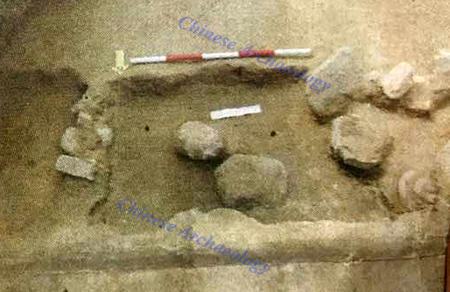
Pool C4
6 tombs in total were unearthed. Tomb M6 was a rectangular earthen shaft tomb, within which a human skeleton was recovered without coffin. The skeleton was placed head to the south, faced up in extended supine position. No burial goods were discovered. The tomb is dated to the Tang Dynasty.
There were 2 footpaths, one of which L1 was east-west aligned, dating to the early Tang Dynasty. White porcelains and black-glaze porcelains were found under the L1. A line of stones was found on each side of L2. The archaeological remains found in the path include blue-and-white porcelain plates, bowls, tri-color glazed pottery Sancai, white porcelains, black enamel, ovens and so forth. The findings indicate that the road was constructed during the Ming Dynasty.
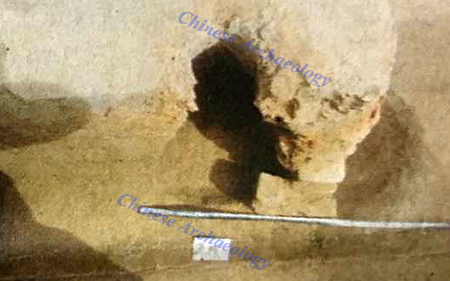
Oven Z34
In terms of 3 ash ditches, the ditch G2 has a shape a like crescent, with inclined walls and a rough bottom. While ditch G2 belongs to the Ming Dynasty, ditch G3 is dated to the Song Dynasty. G3 was trumpet-shaped, where coins and brass belt hooks were discovered.
As many as 15 house foundations were discovered. A large collection of pottery and porcelains were found within them. Ovens (pottery kitchen ranges) were attached in most of those houses. In house F5, 10 Ovens (Z5—Z14) in total were built inside.
J1 and J2 are the two water wells. J1 had a rectangular opening, straight walls, and a flat bottom. Several horse-shoe shaped holes (steps?) were made symmetrically on the west and east walls for the convenience of workers during the construction. Fine clay grey pottery mixed with sand, li (drinking vessels), pots and basins were recovered, belonging to the East Zhou Dynasty. Well J2 had a round opening and straight walls, where were also horse-shoe shaped holes (steps?) made symmetrically on the east and west walls. Remains collected from this well include pots and water-spout (water dropper). The date of this well is probably Tang Dynasty.
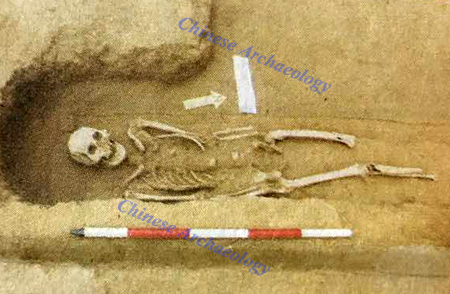
Tomb M6
There were 7 pools of different functions, among which there were 3 filter pools, 4 coal storage pools. Pools C3, C4, C5 were buried with tri-color glazed ware Sancai, porcelain bowls, pots, water-spout (water dropper), ovens, bo bowl and cups, which are suggestive of their function as the filter pools dating to the Tang Dynasty. In both pool C6 and C7 coal residue were found at the bottom. In pool C7 there was also a discovery of a bronze mirror.
Among the 34 ovens (kitchen ranges), Z1, Z2, Z15 and Z34 were made of bricks, while the remaining Gourd-shape ovens (kitchen ranges) were attached to the house floors.
Unearthed cultural relics
The archaeological assemblage collected from the site include tri-color glazed ware Sancai, unglazed porcelains, green, yellow, blue glazes, bi-colored ceramics, white porcelains, black glazed ceramics and brown-glazed ceramic. The vessel types include tripod incense burner, water washer, three-knots pot, four-knots jar, bo bowl, bottle, chicken-head-spout ewer, drinking vessel with five foots, bowl, cup, pillow, raised-stem dish, small cup and plate. Kiln furniture including tripod standings, cylindrical standings, bowl-shaped standings, and rectangular and round backing board. The symbols such as numbers and Chinese characters were found carved on these kiln furniture.
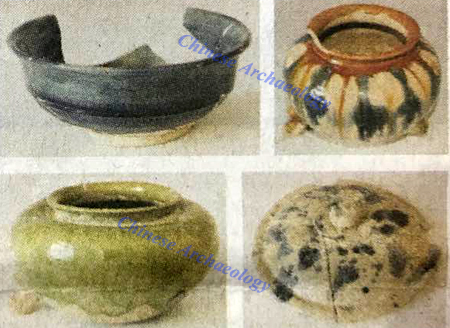
Porcelain unearthed from the site
Academic contribution
During the excavation, a large number of kiln ovens, filter pools, ash pits and cave-dwellings were discovered along with findings of ceramics dating to the Sui and Tang Dynasties. Among them three small round kilns, which varied from the pottery kiln types usually found in the north China during the Tang Dynasty very likely might have functioned as firing lime rather than ceramics. The three kilns will contribute to our understanding of the porcelain manufacture in the Tang Dynasty. As many as 500 pieces of porcelain have been restored from the excavation, which profoundly expands the collection of the Gongyi ware. This excavation will certainly make a salient contribution to the study of ancient kiln and porcelain manufacture. (Translator: Dong Ningning)

Three Kilns numbered Y2, Y7 and Y8 , dating back to the early Tang Dynasty
8 kilns have been discovered in total. In addition, there were 16 ash pits, 6 tombs, 2 footpaths, 3 ash ditches, 15 house-remains, 34 pottery kitchen ranges, 7 pools and 2 water wells found in the site.
The 8 kilns varied in shape. Kiln Y2, Y7 and Y8 were spoon-shaped, probably dating to the early Tang Dynasty. As white ashes and stones were filled inside, those kilns might have been used to produce limes. Kiln Y6 was oval-spoon shaped. The firebox was located in the west part, forming a wedge-like shape. This kiln, resembling kilns Y2, Y7 and Y8, was also dated to the early Tang Dynasty. Very likely, it was used for firing pottery ware.

House foundation F5

Footpath dating back to the early Tang Dynasty found in T0131,which is overlying on the lime kiln
Totally 16 ash pits were discovered. In kiln H1, H2, H5, H7, H12, H17 and H18, tri-color glazed pottery Sancai fragments were collected together with kiln furniture, pottery mould and ovens. Chronologically, they might have been used during the Tang Dynasty. Pit H8, where figure mould, tri-color porcelain, and Jun porcelain plates were deposited, probably was dated to the Song Dynasty. Pit H10 was oval shaped, of which the wall was irregularly constructed. Within the pit, porcelain pots and pottery basins were unearthed, indicating its function as a coal storage pit. Pits H3, H4 and H6 belong to the Ming Dynasty, indicated by the discovery of black-patterned over white ground porcelains, bowls and blue-and-white porcelains. Pits H14 and H15 were remains of two cave-dwellings.

Pool C4
There were 2 footpaths, one of which L1 was east-west aligned, dating to the early Tang Dynasty. White porcelains and black-glaze porcelains were found under the L1. A line of stones was found on each side of L2. The archaeological remains found in the path include blue-and-white porcelain plates, bowls, tri-color glazed pottery Sancai, white porcelains, black enamel, ovens and so forth. The findings indicate that the road was constructed during the Ming Dynasty.

Oven Z34
In terms of 3 ash ditches, the ditch G2 has a shape a like crescent, with inclined walls and a rough bottom. While ditch G2 belongs to the Ming Dynasty, ditch G3 is dated to the Song Dynasty. G3 was trumpet-shaped, where coins and brass belt hooks were discovered.
As many as 15 house foundations were discovered. A large collection of pottery and porcelains were found within them. Ovens (pottery kitchen ranges) were attached in most of those houses. In house F5, 10 Ovens (Z5—Z14) in total were built inside.
J1 and J2 are the two water wells. J1 had a rectangular opening, straight walls, and a flat bottom. Several horse-shoe shaped holes (steps?) were made symmetrically on the west and east walls for the convenience of workers during the construction. Fine clay grey pottery mixed with sand, li (drinking vessels), pots and basins were recovered, belonging to the East Zhou Dynasty. Well J2 had a round opening and straight walls, where were also horse-shoe shaped holes (steps?) made symmetrically on the east and west walls. Remains collected from this well include pots and water-spout (water dropper). The date of this well is probably Tang Dynasty.

Tomb M6
There were 7 pools of different functions, among which there were 3 filter pools, 4 coal storage pools. Pools C3, C4, C5 were buried with tri-color glazed ware Sancai, porcelain bowls, pots, water-spout (water dropper), ovens, bo bowl and cups, which are suggestive of their function as the filter pools dating to the Tang Dynasty. In both pool C6 and C7 coal residue were found at the bottom. In pool C7 there was also a discovery of a bronze mirror.
Among the 34 ovens (kitchen ranges), Z1, Z2, Z15 and Z34 were made of bricks, while the remaining Gourd-shape ovens (kitchen ranges) were attached to the house floors.
Unearthed cultural relics
The archaeological assemblage collected from the site include tri-color glazed ware Sancai, unglazed porcelains, green, yellow, blue glazes, bi-colored ceramics, white porcelains, black glazed ceramics and brown-glazed ceramic. The vessel types include tripod incense burner, water washer, three-knots pot, four-knots jar, bo bowl, bottle, chicken-head-spout ewer, drinking vessel with five foots, bowl, cup, pillow, raised-stem dish, small cup and plate. Kiln furniture including tripod standings, cylindrical standings, bowl-shaped standings, and rectangular and round backing board. The symbols such as numbers and Chinese characters were found carved on these kiln furniture.

Porcelain unearthed from the site
Academic contribution
During the excavation, a large number of kiln ovens, filter pools, ash pits and cave-dwellings were discovered along with findings of ceramics dating to the Sui and Tang Dynasties. Among them three small round kilns, which varied from the pottery kiln types usually found in the north China during the Tang Dynasty very likely might have functioned as firing lime rather than ceramics. The three kilns will contribute to our understanding of the porcelain manufacture in the Tang Dynasty. As many as 500 pieces of porcelain have been restored from the excavation, which profoundly expands the collection of the Gongyi ware. This excavation will certainly make a salient contribution to the study of ancient kiln and porcelain manufacture. (Translator: Dong Ningning)
Category: English
News
Information
Key words:
